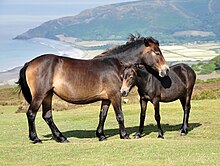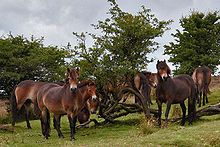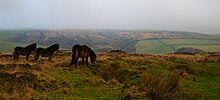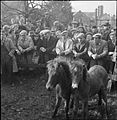Exmoor pony
 A herd of Exmoor ponies | |
| Other names | Celtic pony |
|---|---|
| Country of origin | United Kingdom |
| Traits | |
| Distinguishing features | Mealy markings around eyes and muzzle, "ice tail", "toad eye" |
The Exmoor pony is a horse breed native to the British Isles, where some still roam as semi-feral livestock on Exmoor, a large area of moorland in Devon and Somerset in southwest England. The Exmoor has been given "endangered" status by the Rare Breeds Survival Trust, and "threatened" status by The Livestock Conservancy. It is one of the British Isles' mountain and moorland pony breeds, having conformation similar to that of other cold-weather-adapted pony breeds. The Exmoor pony is hardy and used for a variety of equestrian activities. In its free-roaming state, the breed's presence on Exmoor contributes to the conservation and management of several natural pasture habitats.
Equines have been present in Britain since 700,000 BC, and fossil remains have been found in the area of Exmoor dating back to about 50,000 BC. Some claim that the breed has been purebred since the ice age; this is unsupported by modern DNA research. There is however a close morphological resemblance to the primitive wild horse. Archeological investigations have shown that horses were used for transport in the southwest of England as early as 400 BC, and Roman carvings show ponies phenotypically similar to the Exmoor pony.
The Domesday Book records ponies on Exmoor in 1086, and descendants of ponies removed from the moor in 1818 form the foundation bloodstock of today's Exmoor breed, although a breed society was not formed until 1921. The breed nearly became extinct after the Second World War, owing to soldiers using them for target practice and thieves killing them for their meat. After the war a small group of breeders worked to save the Exmoor, and during the 1950s ponies began to be exported to North America. The first stud book was published in 1963, and in 1981 publicity resulted in increased interest in the breed. As of 2010 there were an estimated 800 Exmoor ponies worldwide. The Exmoor Pony Society currently states that "There are now approximately 500 ponies on Exmoor and a further 3,500 in locations across the UK and several other countries. Although numbers are healthy, the vast majority of ponies are in non-breeding situations."
Characteristics

Exmoor ponies are usually a variant of dark bay, called "brown", with pangaré ("mealy") markings[1] around the eyes, muzzle, flanks, and underbelly. Pangaré markings occur in other equines as well as horses, and are considered to be a primitive trait. Entry in the breed registry requires that the animal have no white markings. They usually stand 11.1 to 12.3 hands (45 to 51 inches, 114 to 130 cm), with the recommended height limit for mares being 12.2 hands (50 inches, 127 cm) and that for stallions and geldings 12.3 hands (51 inches, 130 cm). However Exmoors may be taller than this limit with some reaching 13.2hh [2]
With a stocky, powerful build, the Exmoor pony is strong for its height, and noted for its hardiness and endurance.[3] The chest is deep and the back broad, the croup level. The legs are short, with good bone and hard hooves.[2] Although many sources state that the Exmoor has a distinctly different jaw structure from other horse breeds, which includes the beginnings of development of a seventh molar, this is a misunderstanding based on an incorrect translation of a German study. The study, when properly translated, refers to a feature, found in multiple horse breeds and perhaps all animals with sizable lower jaws, that appears to be an extra branch of blood supply in the area. While an extra tooth may have eventually developed from this extra blood supply, its frequency among the general horse population makes its appearance in the Exmoor pony unremarkable.[4]
The head is somewhat large in proportion to the body, with small ears, and has a unique feature called a "toad eye" caused by extra fleshiness of the eyelids, which helps to deflect water and provide extra insulation. As with most cold-weather pony breeds, the Exmoor grows a winter coat consisting of a highly insulating woolly underlayer and a topcoat of longer, oily hairs that prevent the undercoat from becoming waterlogged by diverting water down the sides of the animal to fall from just a few drip areas. The mane and tail are thick and long, and the dock of the tail is of a type common in cold-weather ponies, having coarse hairs, called a "frost cap," "snow chute," or "ice tail" that deflects rainwater away from the groin and underbelly areas to fall from the long hairs on the back of the hind legs.[3][4]
History

The Domesday Book mentions ponies in Exmoor in 1086. At the end of the joint Hill and Darch wardenship of the Royal Exmoor Forest in 1748, all free-living ponies except agistered horses were removed from the moor and Forest. After that in 1767 Sir Thomas Acland I brought in a new herd of ponies and turned them out on the moor. Sales records of these horses in 1805 and 1809 list the colors black, grey, bay, dun, 'chasnut', and piebald. In 1818 nearly the entire moor was sold to John Knight. Sir Thomas Acland, the previous warden, took some of the horses to Winsford Hill, while others were sold. Starting in 1826, Knight crossed the remaining ponies with Arabians, Thoroughbreds, and other breeds to increase their size. It is said that the modern Exmoor pony descends from the Acland herd. By the late nineteenth century, the Exmoors were being selectively bred for the characteristic mealy muzzle. At first the Exmoor Pony Society accepted grey and black ponies in addition to bay, though the colour standards have been tightened since.[5]
In 1893, the ponies were described in Sidney's Book of the Horse as around 12 hands (48 inches, 122 cm) high, usually bay in color, and with conformation similar to what it is today. In the late 1800s, the National Pony Society began to register Exmoors and Exmoor crossbreds. In 1921, the Exmoor Pony Society was formed, and published its first stud book in 1963.[6]
The Second World War led to a sharp decrease in the breed population as the moor became a training ground. The breed nearly became extinct, with only 50 ponies surviving the war.[7] This was partially due to soldiers using some ponies for target practice and others being stolen and eaten by people in the cities.[8] After the war, a small group of breeders, including Mary Etherington,[9] continued to preserve the population, and publicity in 1981 resulted in increased interest in the breed.[6] The first Exmoors in North America were imported to Canada in the 1950s, and several small herds are still maintained there.[10] In the 1990s, small herds of Exmoor ponies were established in various areas of England. These herds are used to maintain vegetation on nature reserves, many being managed by organisations such as the National Trust, Natural England, and County Wildlife Trusts.[11]
Every purebred registered Exmoor is branded with a four-point star on the near (left) shoulder until the 2000s which attracted criticism.[12] However it is now limited to semi feral ponies as the breeders' choice. In 2000, the Moorland Mousie Trust, a British organisation, was established to assist in the preservation of the Exmoor pony. There is little market for Exmoor colts, so the organisation works to raise funds for the gelding and training of these horses.[13]

Currently, The Livestock Conservancy considers the population of the Exmoor to be at "threatened" levels,[14] meaning that the estimated global population of the breed is less than 5,000 and there are less than 1,000 registrations annually in the US.[15] The UK Rare Breeds Survival Trust considers the breed to be "endangered",[16] meaning that population numbers are estimated to be less than 500 in Great Britain.[17] The Equus Survival Trust considers the breed to be "critical", meaning that there are between 100 and 300 active adult breeding mares.[18] As of 2010, there were estimated to be around 800 Exmoor ponies worldwide.[19]
Prehistoric origin theories
Some claim that the Exmoor pony descends directly from the wild horses of north-west Europe, uninfluenced by domestic horses.[20] However, modern DNA research to date does not support that view,[5] as existing studies indicate they share their maternally inherited mitochondrial DNA with various other horse breeds from across the world,[21] and their paternally inherited Y-chromosome is identical to that of most other domesticated horses.[22]
Wild horses have lived in Britain for hundreds of thousands of years. Some remains found date as early as 700,000 BC,[23] while others are as recent as 3,500 BC.[24] However, no genetic studies to date have correlated these prehistoric remains to any modern breed. What has been studied are Y-chromosomes (Y-DNA) and mitochondrial DNA (mtDNA) obtained from Exmoor ponies. The Y-chromosome is passed on through the male line, and worldwide shows very little genetic variation in horses,[22] except for a second Y-chromosome haplotype found in China,[25] suggesting that a very limited number of stallions contributed to the original genome of the domestic horse. The Exmoor pony shares this general Y-chromosome haplotype.[22] In contrast, mitochondrial DNA is passed on though the female line, and shows far more variation than Y-DNA, indicating that a large number of wild mares from several regions have contributed to modern domestic breeds.[26][27] Some mtDNA-haplotypes have been found in DNA samples obtained from wild horses in prehistoric deposits, while other mtDNA-haplotypes have only been found in domesticated horses, from both living individuals and archeological finds.[21] The Exmoor pony has a high frequency of pre-domestication mtDNA-haplotypes, but these are also found in different breeds all around the world.[21] Currently, for the British Isles, there are only three DNA archeological samples available, all from Ireland.[28]
Although wild horses were abundant after the last ice age,[29] the lack of sufficient pre-domestication DNA samples makes it impossible to determine the contribution of the wild horses of the British Islands to modern breeds, including the Exmoor pony.[28] A 1995 study of morphological characteristics, the outward appearance of organisms, indicated that the Exmoor, the Pottock, and the now-extinct Tarpan have an extremely close resemblance; these breeds were consistently grouped together in the results from several analyses, with the Exmoor showing the closest relationship to the Tarpan of all the breeds studied, at 0.27; the next-closest breeds to the Tarpan were the Pottock and Merens, both with a genetic distance from the Tarpan of 0.47. The distance between the Exmoor and Pottock was 0.37, and between the Exmoor and Merens was 0.40; a significantly wider gap than the distance between the Exmoor and Tarpan.[30]
The first indication of domesticated horses in England comes from archaeological investigations showing that the ancient Britons were using wheeled horse-drawn transport extensively in southwest England as early as 400 BC.[31] Recent research has indicated that there was significant Roman involvement in mining on Exmoor.[32] Metals including iron, tin, and copper were transported to Hengistbury Head in neighbouring Dorset for export,[33] and Roman carvings, showing British and Roman chariots pulled by ponies phenotypically similar to the Exmoor, have been found in Somerset.[34][35][36][37]
Uses
In the past, Exmoors were used as pit ponies.[38] Ponies not kept in semi-feral conditions are used for a variety of activities including showing, long-distance riding, driving,[3] and agility. Exmoor ponies won both divisions at the International Horse Agility Championships in 2011,[39] and took a third title at the 2012 Championships.[40] The breed's hardiness makes it suitable for conservation grazing, and it contributes to the management of many heathland, chalk grassland and other natural pasture habitats, as well as to the conservation of Exmoor itself.[11]
A herd of 14 Exmoors from Exmoor National park were moved to the former military base of Milovice (Nymburk District), Czech Republic, in an effort to improve biodiversity by conservation grazing, in January 2015. According to the annual count of 2019, this population has increased to 111 ponies. [41] [42]
Gallery
-
Bampton Fair- Pony, Sheep and Cattle Sales in the Village of Bampton, Devon, England, UK, October 1943. Ponies were often sold here after gathering in the Autumn.
-
Exmoor Stallion Dunkery Wigeon at the Royal Highland Show 2018
References
Notes
- ^ Sponenberg 2003, p. 30.
- ^ a b "Rules of the Exmoor Pony Society — Breed Standard". Exmoor Pony Society. May 2013. Archived from the original on 19 April 2014. Retrieved 18 April 2014.
- ^ a b c Dutson 2005, p. 301.
- ^ a b "Exmoor Pony". International Museum of the Horse. Retrieved 15 April 2014.
- ^ a b Green, Peter. "The free-living ponies within the Exmoor National Park: their status, welfare and future" (PDF). Exmoor National Park. Retrieved 13 November 2020.
- ^ a b Dent & Hendricks 2007, pp. 180–181.
- ^ "Exmoor Ponies – a dying breed?". BBC Somerset. Retrieved 3 December 2007.
- ^ Dutson 2005, pp. 300–301.
- ^ "Persecuted Exmoor ponies trot back from the brink". Retrieved 9 October 2018.
- ^ "Exmoor Pony". Oklahoma State University. Retrieved 2 December 2010.
- ^ a b "Map of UK Conservation Grazing Schemes". Grazing Animals Project. 18 April 2012. Archived from the original on 14 March 2014. Retrieved 15 May 2012.
• "Wildlife Conservation of Local Downland and Heathland". Sussex Pony Grazing and Conservation Trust. Retrieved 15 May 2012.
• "Grazing Exmoor ponies to protect County Durham flowers". BBC News. 8 March 2011. Retrieved 15 May 2012. - ^ Tierney-Jones, Adrian (19 November 2009). "Exmoor ponies at centre of controversial branding issue". The Telegraph. Retrieved 23 November 2009.
- ^ "Pfizer helps Exmoor ponies". The Horse. 18 October 2002. Retrieved 2 December 2010. (subscription required)
- ^ "Breed Information – ALBC Conservation Priority Lis t". American Livestock Breeds Conservancy. Retrieved 2 December 2010.
- ^ "Parameters of Livestock Breeds on the ALBC Conservation Priority List (2007)". American Livestock Breeds Conservancy. Retrieved 2 December 2010.
- ^ "Watchlist-Equines". Rare Breeds Survival Trust. Archived from the original on 25 August 2011. Retrieved 2 December 2010.
- ^ "Watchlist". Rare Breeds Survival Trust. Archived from the original on 24 March 2009. Retrieved 2 December 2010.
- ^ "Equus Survival Trust Equine Conservation List" (PDF). Equus Survival Trust. Retrieved 2 December 2010.
- ^ "Exmoor Pony". American Livestock Breeds Conservancy. Retrieved 2 December 2010.
- ^ Hovens, Hans; Rijkers, Toon. "On the origins of the Exmoor pony: did the wild horse survive in Britain?" (PDF). Ecological Research Centre Faunaconsult, Tegelseweg. Retrieved 5 January 2016.
- ^ a b c Cieslak, Michael; Pruvost, Melanie; Benecke, Norbert; Hofreiter, Michael; Morales, Arturo; et al. (2010). "Origin and History of Mitochondrial DNA Lineages in Domestic Horses". PLOS ONE. 5 (12:e15311): e15311. doi:10.1371/journal.pone.0015311. PMC 3004868. PMID 21187961.
{{cite journal}}: CS1 maint: unflagged free DOI (link) - ^ a b c Lindgren, Gabriella; Backstrom, Niclas; Swinburne, June; Hellborg, Linda; Einarsson, Annika; et al. (1985). "Limited number of patrilines in horse domestication" (PDF). Nature Genetics. 36 (4): 335–6. doi:10.1038/ng1326. PMID 15034578. S2CID 38310144. Archived from the original (PDF) on 19 July 2011.
- ^ Stuart, Tony (2006)"Exotic world before Suffolk", British Archaeology (86). Retrieved 22 March 2011. Archived page
- ^ Daniel 1950, p. 173.
- ^ Ling, Yinghui; Ma, Yuehui; Guan, Weijun; Cheng, Yuejiao; Wang, Y.; et al. (2010). "Identification of Y chromosome genetic variations in Chinese indigenous horse breeds". Journal of Heredity. 101 (5): 639–43. doi:10.1093/jhered/esq047. PMID 20497969.
- ^ Jansen, Thomas; Forster, Peter; Levine, Marsha A.; Oelke, Hardy; Hurles, Matthew (2002). "Mitochondrial DNA and the origins of the domestic horse". PNAS. 99 (16). et al.: 10905–10910. doi:10.1073/pnas.152330099. PMC 125071. PMID 12130666.
- ^ Vilà, Carles; Leonard, Jennifer A.; Götherström, Anders; Marklund, Stefan; Sandberg, Kaj; et al. (2001). "Widespread origins of domestic horse lineages". Science Magazine. 291 (5503): 474–77. doi:10.1126/science.291.5503.474. PMID 11161199.
- ^ a b McGahern, A. M.; Edwards, C. J.; Bower, M. A.; Heffernan, A.; Park, S. D. E.; et al. (2006). "Mitochondrial DNA sequence diversity in extant Irish horse populations and in ancient horses". Animal Genetics. 37 (5): 498–502. doi:10.1111/j.1365-2052.2006.01506.x. PMID 16978181.
- ^ Woodman, Peter; McCarthy, Margaret; Monaghan, Nigel (1997). "The Irish quaternary fauna project". Quaternary Science Reviews. 16 (2): 129–59. doi:10.1016/S0277-3791(96)00037-6.
- ^ Jordana, J; Pares, P. M; Sanchez, A (1995). "Analysis of genetic relationships in horse breeds" (PDF). Journal of Equine Veterinary Science. 15 (7): 320–328. doi:10.1016/S0737-0806(06)81738-7.
- ^ Johns & Potter 2002, p. 24.
- ^ Brown, Bennett & Rhodes 2009, pp. 50–61.
- ^ Johns & Potter 2002, p. 28.
- ^ Budd 1998.
- ^ "Exmoor Pony". Exmoor Ponies in Conservation. Archived from the original on 1 October 2011. Retrieved 17 April 2011.
- ^ Grout, James. "The British War-Chariot". Encyclopedia Romana. University of Chicago. Retrieved 29 September 2015.
- ^ Johnstone, Cluny Jane. "A Biometric Study of Equids in the Roman World" (PDF). University of York. Archived from the original (PDF) on 5 October 2012. Retrieved 17 April 2011.
- ^ Wynmalen, Henry (1971). Horse Breeding & Stud Management. J. A. Allen. p. 83. ISBN 978-0-85131-139-5.
- ^ "Exmoor pony Bear is top of the world". West Somerset Free Press. 6 January 2012. Retrieved 24 February 2016.
- ^ "Bear's on top of the world again". West Somerset Free Press. 3 January 2013.
- ^ "Czechs import wild horses to save biodiversity". cbsnews.com.
- ^ "Wild horses and aurochs on pasture are now streaming". idnes.cz.
Bibliography
- Brown, Antony; Bennett, Jenny; Rhodes, Edward (April 2009). "Roman mining on Exmoor: a geomorphological approach at Anstey's Combe, Dulverton". Environmental Archaeology. 14 (1): 50. CiteSeerX 10.1.1.506.1731. doi:10.1179/174963109X400673. S2CID 131103246.
- Budd, Jackie (1998). Horse and pony breeds. Gareth Stevens. ISBN 978-0-8368-2046-1.
- Daniel, Glynn (1950). The Prehistoric Chamber Tombs of England and Wales. Cambridge University Press.
- Dent, Anthony Austen; Hendricks, Bonnie L. (2007). International Encyclopedia of Horse Breeds. University of Oklahoma Press. ISBN 978-0-8061-3884-8.
- Dutson, Judith (2005). Storey's Illustrated Guide to 96 Horse Breeds of North America. Storey Publishing. ISBN 978-1-58017-613-2.
- Johns, Catherine; Potter, Timothy W. (2002). Roman Britain. British Museum Press. ISBN 978-0-7141-2774-3.
- Sponenberg, Dan Phillip (2003). Equine color genetics (2nd ed.). Wiley-Blackwell. ISBN 978-0-8138-0759-1.
Further reading
- Morrison, Alex (1980). Early man in Britain and Ireland: an introduction to Palaeolithic and Mesolithic cultures. Croom Helm. ISBN 978-0-85664-084-1.
- Smith, Christopher (1992). Late Stone Age hunters of the British Isles. Routledge. ISBN 978-0-415-07202-1.


